(Vietnamese title: Đi xe máy như một cảm hứng, from the book "Xe máy tiếu ngạo")
The motorbike,
more than just a means to travel and leisure, is a symbol of freedom, youth,
and the inspiration of the open road. Of course, the big-engine bikers now
roaming the vast highways of the world must appreciate those riders that came
before them, who, through the ways they rode, and the reasons they rode, turned
this machine into a cultural phenomenon.

Although it may
not be the exact birth-point of this trend, one place to start is with Che
Guevara, who at age 23 journeyed across Latin America accompanied by his friend
Alberto Granado. Their trip, far from two South American boys on a joyride,
became a journey through which they discovered their ideals. Over nine months,
they covered a distance of some 8,000km, riding their 500cc Norton across a
series of countries with a shared language and a continuum of cultures. After a
first attempt in early 1950 on a motorized bicycle, the motorcycle voyage
important here began in January of 1952, using a well-worn ‘39 model that they
named La Poderosa (“The Mighty One”). From their experiences, Che would write
the famous Motorcycle Diaries,
recording what he saw and heard, as well as his vision of a struggle for social
equality. Che became a symbol of revolutionary youth, and his motorcycle
journey came to be regarded as the wellspring of his universal dream, in which
all young people might engage, provided they invest a bit of material and a
great deal of heart. Granted, they were forced to abandon their bike in the
middle of the trip after it broke down, but even so, the spirit of this most
liberating of vehicles set the tone for the rest of their adventure. We still
wonder at these committed revolutionaries, who resolved to set out on the road
carrying little but themselves, and yet who managed to achieve great distances,
and great things, out there on the road of history. Who knows how much of this destiny was inspired by their old
rattletrap bike, so unlike the thundering legend born from the minds of
historians and the weavings of our popular imagination.
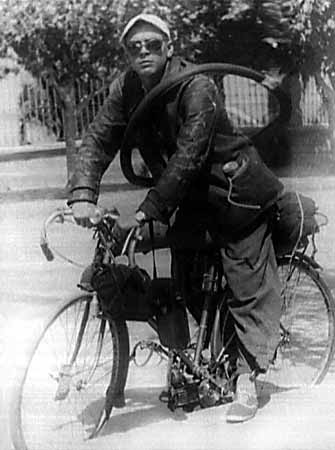 |
| Che on a his bike in 1950 |
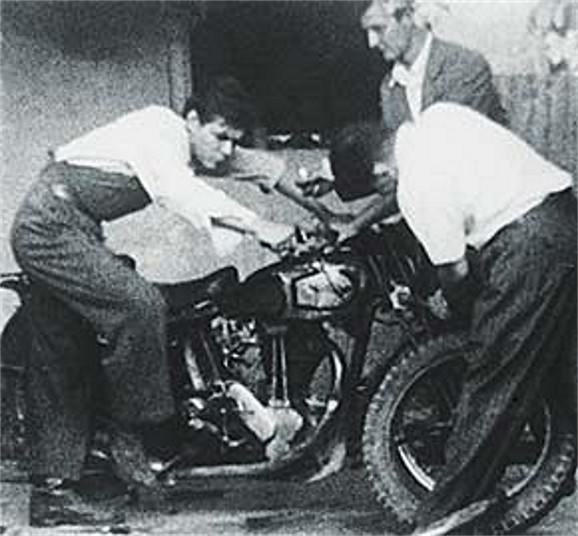 |
| Che's La Poderosa |
The travels of
Che and Alberto were meant to get them a firsthand look at the society of the
mid-20th century, a corner of the world at the outset of the Cold War, when the
US saw Latin America as their “backyard.” The pair gave medical treatment to
patients with leprosy and tuberculosis, both considered incurable at the time.
They did this without fear or care for their own suffering, treating the sick
without gloves or quarantine, even playing soccer with them. Their
revolutionary inspiration would go on to sweep the continent in the years to
come. When their bike broke down, the patients that Che and Alberto treated
fashioned them a simple raft to float down the Amazon River. Che had left
behind a romance and the swell life of a future doctor in order to further his
commitments. Che’s girlfriend sent him 15 dollars in order to buy a swimsuit
for her should he happen to visit the US (and come to the US he did! Here is
Miami, the end of the road)[1],
but Che gave the cash to a poor farming family he came across. That is
something truly too romantic, to imagine riding our motorbikes from Vietnam to
Japan with money in our pocket to buy a kimono in Japan, but could we imagine
ourselves giving away that cash on the street instead? Che and his friend were
not aiming for urban luxury, but for “the people at the bottom of the city, the
beggars. Our noses would breathe the same air as the miserable.” The motorbike
was the first object of a roadtrip that was at once ecstatic and, in its time,
as yet unaware that it bore early witness to the most important story of the
twentieth century: people’s liberation.
 |
| The cover of Che's book |
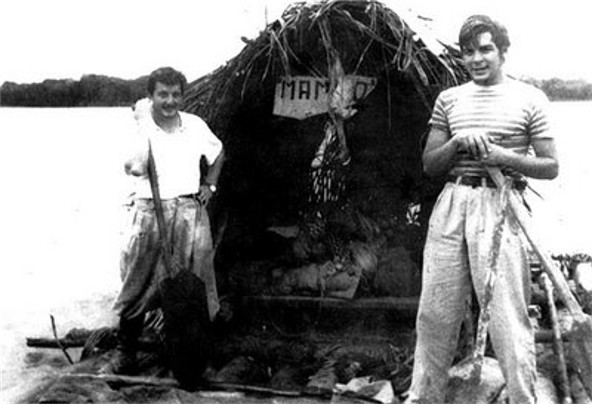 |
| Che with Alberto on the raft Mambo-Tango |
Verso, the
publishing house that first brought out The
Motorcycle Diaries, called it “Karl Marx’s Das Kapital meets Easy Rider.”
At another time, in another sense, Easy
Rider[2]—
an American film made in 1969—also dealt with the subjects of youth and
rebellion. The final years of the
Sixties marked a sharp change in the lives of
young Westerners, with its hippy movement, rock music, drug use, and
protests against the war in Vietnam. Peter Fonda and Dennis Hopper starred as
the film’s two protagonists, clad in leather jackets, an American flag
emblazoned across Fonda’s helmet and chopper as they travel across the
Southwest and Deep South of the USA. The pair embody an “On the Road”
generation a la Jack Kerouac, and they are looking to find something beyond the
empty materialism which, to them, embodied the conventional American Dream of
the era. The film seems merely to
depict the misadventures of two drug dealers bound for the South, but it also
affords us a look into America’s dark corners and insecurities. The tagline of
the film expresses its spirit of hopelessness: “One man went looking for
America and couldn’t find it anywhere.”
Audiences fell
in love with this movie for the realism with which it treats these rebels’
lives outside the law, their hallucinations and shattered inspiration. This in
the context of that simultaneous corruption of old values and explosion of new
needs which defined the “baby boom” generation (the generation born after WWII,
when the birthrate surged). More than that, this generation demanded
acknowledgement and a confirmation of its own values in an era when America was
bogged down in the quagmire of Vietnam and the escalation of the Cold War.
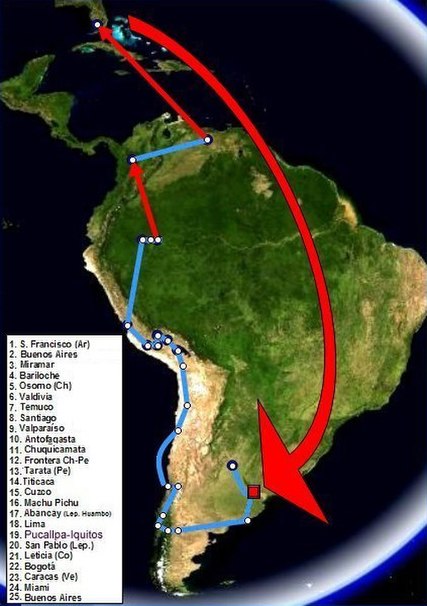 |
| Che's journey map . The blue line was by motorcycles. The red was primarily by planes. |
'
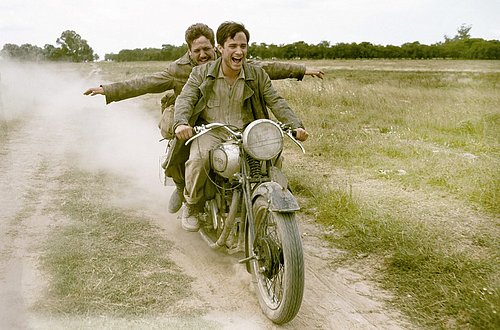 |
| One scene from the movie in 2004 based on the book Che's 'The motorcycle diaries' with actor Gael García Bernal as Che and Rodrigo de la Serna as Alberto. |
It was not
random that the motorcycle became a defining feature of this youthful
generation’s way of life. From Jack London’s ragged “iron heeled” shoes[3] at the beginning of the 20th Century, to the
automobiles of Jack Kerouac and the other Beat authors in the years 1947-1950,
to the motorcycles of the new generation, all were chosen on a shoestring
budget, but with more than enough passion. Now, admittedly, the Harley-Davidson
chopper featured in Easy Rider was by
no means cheap. In fact, it was a top-of-the-line model, a rare species of
machine in the same class as a yacht or a sports car… After the commercial and
artistic success of Easy Rider (which
grossed 42 million dollars), there were countless movies, songs and lifestyle
products inspired by the film. All of them, however, partook of a common
denominator: the imagine of a lone outlaw riding his bike into the distance.
All of this, however, remains difficult for Vietnamese audiences to interpret,
given the fact that for nearly all of us, the motorbike is the main vehicle for
everyday, routine getting-around.
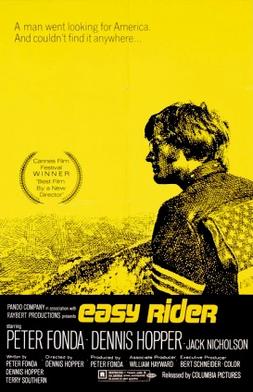

Above all, out
of all our means of transport, the motorbike remains the cheapest and most
mobile. Try to imagine how it would have been if Che had used a car instead:
perhaps his rendezvous with destiny out there on the road would not have been
quite the same as what took place when he rode that rusty motorcycle. The look
of a rider exposed to dust and fumes, wind and fog, rain and snow, is
absolutely different from that of one who sits behind a steering wheel. The
motorbike’s route also weaves more readily through the curving narrow streets
and sharp corners of life, from the indigenous villages of the high Andes to
the vice-filled backlots of Lousiana, places that a four-wheeled car restricted
to highways just cannot access. For the real-life motorcycle journey which
inspired revolutionary ideals, as much as for the purposeless joyride in the
movie, it was the longing for free horizons that first inspired their youthful
protagonists. The changes they experienced on the road were just what they were
expecting. Their lack of concern for accidents and risks stands in exact
opposition to our modern consumer society, which strives to sell its members
the very latest solutions for safety and convenience. The funny thing is that
both Che and Easy Rider would become
highly commercialized icons, exactly the opposite of what launched either onto
the road. Today we can see Che everywhere, on posters, t-shirts, and coffee
mugs. Easy Rider became shorthand for
a style of life and fashion similar to that of the English rock stars splashed
across the era’s entertainment pages. The idea of finding life’s values
somewhere “out there,” and of a life that asks people to confront notions of
their own dignity, freedom and happiness, faded beneath all of that
beautifully-branded printing and display.
 |
| Even Barbie becomes a easy rider. |
In Vietnam,
there’s still one form of seeking inspiration through the motorbike ride, and
that’s the phượt, i.e., the
far-ranging camping trip. You can still find them wandering the mountain roads,
the youths of Hanoi or Saigon who have veered away from the 6 million other
bike riders piled into their respective cities, joining together in small
groups for a few days of exile. Sharing in the same global-culture symbolism of
the motorbike discussed above, they head out in search of vast landscapes, wild
and unclaimed, things that the big cities of Vietnam don’t have.
Many Western
tourists, appropriately enough, are introduced to Vietnam in the manner of Easy
Rider, according to the old Vietnamese traveler’s maxim, “Wherever you stop is
your home, wherever you fall is your bed.” Of course, every traveler seeks out
the truly extraordinary, but some of them do so with pen in hand, checking off
the bullet points of a “must-see,” list, the so-called “Bucket List” having
become a familiar concept in today’s society. Clever tourists also embrace this
practice in order to efficiently ply the roads of Vietnam as highlighted by the
Easy Rider touring brand in Sapa and Dalat[4]. For
Westerners, one of the good things about this kind of travel is that they don’t
need to fuss over the Vietnamese repair manual for their ride. There is no need
to communicate; the Vietnamese mechanics who handle the vehicles take care of
everything. Truly an “easy” motorbike for cross-cultural exchange!


Let us return
to the urban youth of Vietnam. They also want to try out their ability to
conquer nature, of course at a very “modern” level, something that
city-dwellers have lost. Those very beautiful, bright and swanky bikes, often
custom built, costing hundreds of thousands or a million dollars and sold to
actors Tom Cruise or Jet Li to ride, seem incapable of sharing in those
legendary bike journeys past through this dusty world of life. Among the crowds
of motorbike riders, often frantic, often flaunting the laws of traffic and the
code of civilized conduct, dragged into a chronic fatigue day after day, month
after month, on their ordinary commuter’s motorbike: how many of these people
think of the two wheels beneath them as a source of inspiration?
(c) Nguyen Truong Quy
Translated by Jacob O. Gold
[1] Che’s final stop on his grand tour was a stint as a
dishwasher at a Miami hotel, in order to raise money for a return ticket to
Buenos Aires. This detail of Che’s biography closely mirror’s Ho Chi Minh’s own
brief sojourns in Boston and New York City.
[2] In the original Vietnamese, the author follows the
English with his own loose translation of the film’s title in parentheses: “tay lái dễ chơi”; loosely rendered back
into English “easy-playing handlebars”
[4] Established in 1994, Easy Rider Motorbike Tours
allows tourists to travel various popular routes through Vietnam, alone or in
groups, on the back of a motorbike piloted by a tour guide. Since its popularity
has grown, many imitators have sprung up (often started by former employees of
the original), leading to bitter rivalries among various “Easy Riders.”

Không có nhận xét nào:
Đăng nhận xét